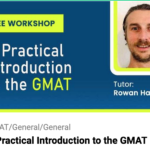A GMAT Probability Problem with Too Many Moving Parts — How to Deal With a Complex Problem by Isolating its Constituent Parts
This problem is so complicated that it’s unlikely to be seen as an actual GMAT Probability question–that is, something you would see in such a complex form on the exam itself–but bear with me. The individual pieces of this technique will be valuable to you in other types of questions.

Not to mention the individual parts are actually all pretty easy–the only complicated part is to figure out how to combine these different parts efficiently.
If three dice are thrown, what is the Probability that the sum of their results is 8?
First: calculate the total possibilities:
It’s always easy to calculate the total number of possibilities. In this case, it is straightforward: we have an Independent (recycling) Probability, and each die has six possibilities. That means that our total number of possibilities is simply:
6*6*6=216
Second, figure out how many of these possibilities sum to 8.
There aren’t going to be all that many ways to sum to 8, but let’s start by looking at our potential possibilities. Remember, as long as the method is consistent, the faster the better because time is of the essence with GMAT Probability questions.
That said, I don’t want to count repeated terms, because this will be a terrible waste of time and effort.
Quite honestly, I’m also pretty confident that I will fuck up the count–as we see soon, there are 21 different ways to do this, so this presents a lot of room for error. Maybe you’re better at these things than me, but let’s avoid hassle.
Let’s say that we pick 1, 1, 6. That means that, following Mississippi, we have 3!2!ways to count these three numbers.
Alternatively, you can just move the six: 1, 1, 6; 1, 6, 1; or 6, 1, 1.
Obviously it’s going to be a colossal time suck to do this for each… what to do?
Bearing this in mind, I want to look for the number of unique combinations of three numbers that sum to 8. There are any number of ways to count them.
In this case, I’m going to keep the left side as low as possible. Note that when the numbers flip–that is, when 1, 3,4 becomes 1, 4,3, for example, this is a signal to move to the next number up on the left side.
1, 1, 6
1, 2, 5
1, 3, 4
(flip up to 2)
2, 2, 4
2, 3, 3
Now you can flip up to 3–note that all of the possibilities with 3 in the first position are taken! Same for 4, 5, and 6, which means we can stop.
This might well make more sense laid out with some notes in the margins. Take a look at this:
In any case, by the time we reach 2, 3, 3, we’ve exhausted all of the possibilities.
Third, now that we have all of the distinct combinations, we need to figure out how many times each one occurs–that is, how many different orders each one can be expressed in.
Now we simply need to figure out how many ways each of these groups can be organized.
Once we’ve sorted that out, we see that there are the following organizations:
1, 1, 6 = 3
1, 2, 5 = 6
1, 3, 4=6
2, 2, 4 =3
2, 3, 3 =3
Total: 21
That is, there are 21 situations where the sum of the numbers on the dice is 8.
Fourth, we simply divide this 21 by the total 216 to achieve the Probability of getting a sum of 8.
In other words…
P(sum of 8)=21216=772
In the next article, we’ll check out how to apply Number of Distributions x Probability per Distribution in GMAT Probability.





